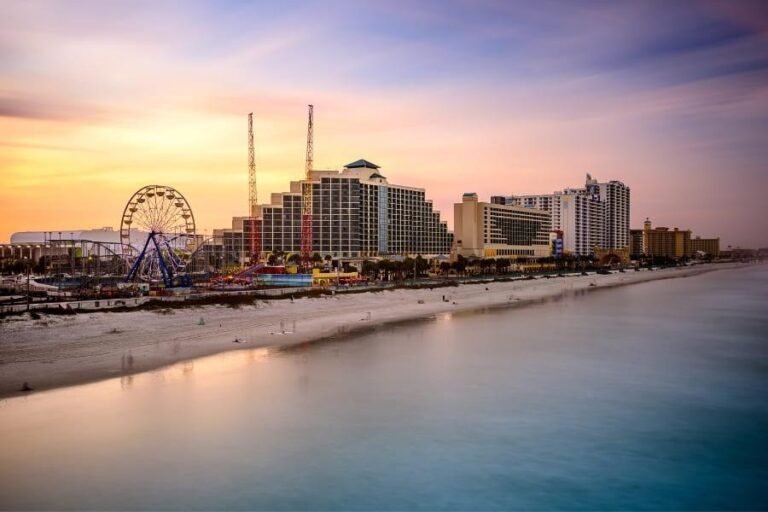When it comes to planning a getaway, selecting the right time to visit your chosen destination can make all the difference between an unforgettable experience and a frustrating one. Daytona Beach, with its sun-kissed shores and vibrant atmosphere, is a favorite among travelers seeking adventure and relaxation alike. However, there are certain times of the year when visiting this iconic beach may come with challenges that can dampen even the sunniest of spirits. From crowded tourist traps during peak season to changing weather patterns that can wreak havoc on your plans, understanding the pitfalls of timing your trip is crucial. In this article, we will explore the worst times to visit Daytona Beach, offering valuable tips to help you avoid these common pitfalls. Whether you’re a seasoned traveler or planning your first trip, our goal is to ensure that you make the most informed decisions for a truly enjoyable experience. So, let’s dive into the factors that can impact your visit, ensuring you can bask in the beauty of Daytona Beach when the conditions are just right.
Understanding the Crowds: When Daytona Beach Becomes Overwhelming for Travelers
Daytona Beach, known for its inviting sands and vibrant boardwalk, can transform into a bustling hub that overwhelms even the most seasoned travelers. Understanding the nuances of crowd dynamics during peak seasons is vital to making your visit enjoyable. Avoiding key dates can significantly enhance your experience; consider planning your trip outside of these crowded periods:
| Peak Crowding Dates | Why It’s Busy |
|---|---|
| Spring break (March - April) | College students flooding the beaches, with parties and events dominating the area. |
| Daytona Bike Week (March) | Motorcycle enthusiasts arriving en masse for the week-long celebration. |
| 4th of July | Fireworks and festivities draw large crowds to the beach and surrounding areas. |
| Labor Day Weekend | Last summer hurrah for families before school starts. |
Travelers looking for a more serene experience might consider visiting during the off-peak periods, such as late fall or early winter, when the weather remains pleasant but the crowds dissipate. Additionally, planning your activities for early mornings or late afternoons can help you avoid the influx of visitors during the day. When exploring the iconic attractions and local eateries, keep an eye out for hidden gems that might not attract the masses. Consider these strategies to create a more intimate and enjoyable visit to Daytona Beach:
- Stay mid-week: Hotels frequently enough have lower rates and thinner crowds.
- Explore lesser-known beaches: Look for quieter spots like Ponce Inlet.
- Engage with locals: They can provide recommendations away from the tourist traps.
- Attend off-season events: Check local calendars for smaller festivals or shows.
By strategically timing your visit and being mindful of local happenings, you can ensure that your trip to Daytona Beach remains both pleasant and memorable, allowing you to experience the destination as it was meant to be enjoyed.
Weather Woes: Navigating Daytona Beachs Least Ideal Conditions for Your Visit
While Daytona Beach is often associated with sun-soaked skies and warm breezes, there are times when unexpected weather can dampen your travel experience. Understanding these less than ideal conditions can help you prepare and make the most of your visit.Here are some factors to keep in mind:
- Hurricane Season: Typically from june to November, this period poses a risk of heavy rains and turbulent winds. Investing in travel insurance is recommended, and keeping an eye on weather updates can help mitigate disruptions.
- Summer Heat: The peak summer months can be sweltering in Daytona Beach, with temperatures often exceeding 90°F (32°C). Plan outdoor activities for early morning or late afternoon when it’s cooler, and stay hydrated.
- rainy Days: Frequent afternoon thunderstorms can occur, especially in June and July.Always pack a lightweight, waterproof jacket and consider indoor alternatives such as local museums or entertainment venues if the weather turns.
- Humidity: The muggy air can be uncomfortable, notably from June through September. Opt for breathable clothing and plan for ample breaks in air-conditioned spots to cool down.
- Winter Chill: While winter is mild,occasional cold fronts can bring temperatures down unexpectedly. Don’t forget to pack layers, as evenings can be quiet cool.
If you want to gauge some typical weather patterns, take a look at the table below, highlighting the average temperature and rainfall for each season:
| Season | Average High (°F) | Average Rainfall (inches) |
|---|---|---|
| Spring | 75-85 | 3-4 |
| Summer | 85-95 | 5-6 |
| Fall | 75-85 | 3-4 |
| Winter | 60-70 | 2-3 |
By preparing for Daytona Beach’s weather woes, you can turn potential obstacles into opportunities for memorable experiences. From exploring local culture during a sudden rain to enjoying the serene beaches in the brisk winter air, each season offers its own unique charm. At Gezify, we believe that with a little preparation, even the least ideal weather can be embraced as part of your adventure.
while Daytona Beach can be a wonderful destination, it’s important for travelers to be aware of the times when the experience may not meet expectations. By avoiding peak hurricane season, the sweltering summer months, and major events that draw large crowds, you can ensure a more enjoyable visit. Remember, planning ahead and being informed can make a significant difference in your overall experience. We hope these tips help you navigate your travel plans more effectively, allowing you to enjoy all the beauty and excitement Daytona Beach has to offer, at just the right time. Safe travels!
